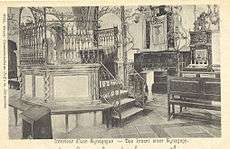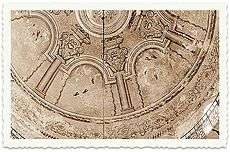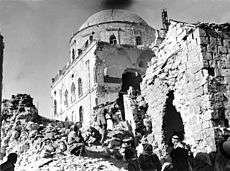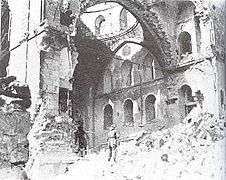Tiferet Yisrael Synagogue

Tiferet Yisrael Synagogue (Hebrew: בית הכנסת תפארת ישראל; Yiddish: Tiferes Yisroel), most often spelled Tiferet Israel, was one of the most outstanding synagogues in the Old City of Jerusalem in the 19th and 20th centuries. It was destroyed by the Arab Legion during the 1948 Arab-Israeli War and left as ruins by the Israeli government after the recapture of the Old City in the Six-Day War. Named after Rabbi Yisroel of Ruzhin, founder of the Ruzhin Hasidic dynasty, it was also known as the Nissan Beck Shul, (Yiddish: ניסן בק שול), after its founder, Rabbi Nissan Beck.[1] In 2012 the Jerusalem municipality announced its approval for plans to rebuild the synagogue.[2] The cornerstone was laid on May 29, 2014.[3]
Origins

Although Hasidim had arrived in Jerusalem by 1747, it was only in 1839 that Rabbi Nissan Beck began plans for a Hasidic synagogue. Until then they had prayed in small, private locations like Rabbi Israel Beck's house.
In 1843 Rabbi Beck traveled from Jerusalem to visit the Ruzhiner Rebbe in Sadigura. He informed him that Czar Nikolai I intended to buy a plot of land near the Western Wall with the intention of building a church and monastery there. The Ruzhiner Rebbe, who was very involved in assisting the yishuv, gave Rabbi Beck the task to thwart the Czar's attempt. Beck managed to buy the land from its Arab owners for an exorbitant sum mere days before the Czar ordered the Russian counsul in Jerusalem to make the purchase for him. The Czar was forced to buy a different plot of land for a church, which is known today as the Russian Compound.[4] When Rabbi Friedman died in 1851, his son, Rabbi Avrohom Yaakov Friedman, the first Rebbe of Sadigura, continued the task of raising the necessary funds for the project.[5]
Construction

Rabbi Beck was the architect and contractor of the project.[6] Initially the Ottoman authorities refused to grant permission to dig the foundations, and when permission was eventually granted, the crew discovered a Muslim sheik's grave on the site. Eventually the Muslim religious judge agreed for the tomb to be moved outside the city walls. After the foundations had been dug, another setback cropped up. It became apparent that it was necessary to obtain a building permit from the officials in Turkey who were not keen to grant the request. Rabbi Beck, an Austrian national, convinced Franz Joseph I of Austria to intercede, and in 1858 a firman was granted. Over ten years were spent raising funds as the building slowly took shape.[5]
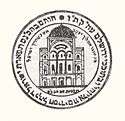
In November 1869 Franz Joseph, en route to the inauguration of the Suez Canal, made a visit to Jerusalem. Included in his itinerary was a tour of the Jewish institutions of the city. When he toured the Old City with Rabbi Beck and others, he asked why the synagogue was standing without a roof. Rabbi Beck quipped, "Why, the synagogue took off its hat in honor of Your Majesty". The Kaiser smiled and replied, "I hope the roof will be built soon," and left the Austrian counsel with 1,000 francs[7] for the dome's construction. From then on, the dome was referred to by locals as "Franz Joseph's cap".[8]
The three-story synagogue was inaugurated on 19 August 1872, 29 years after the land had been purchased. For the next 75 years, it served as the centre for the Hasidic community in the city. It was considered one of the most beautiful synagogues of Jerusalem, with a commanding view of the Temple Mount, ornate decorations, and beautiful silver objects donated by Hasidim.[9]
| Vintage photographs of synagogue interior | ||||||
|---|---|---|---|---|---|---|
|
Destruction

During the Israel War of Independence, the Tiferet Yisrael Synagogue was used as a post by the Haganah in the defense of the Old City. During the Jordanian Legion's campaign to capture the Old City, it blew up the synagogue an hour after midnight on the night of May 20–21, 1948.
| “ | The first major Haganah stronghold to fall was the Nissan Bek Synagogue, the building whose dome had been donated by the Emperor Franz Joseph. It was essential to Rusnack defence plan and the Haganah fought tenaciously to hold on to it…Fawzi el Kutub finally ordered eight of his men to rush across an open space and place a charge at the base of the synagogue. All of them were killed or wounded. No one would volunteer for a second try. Hoping to force his men’s hands by his example, Kutub sprinted across the space himself. When he got to the base of the synagogue, he saw that no one had followed him. Like a spider he pressed himself up against its wall until finally the Tunisian to whom he had promised a wife rushed out to him carrying a fifty-five pound charge. The explosion barely chipped the wall. Three more unsuccessful attempts were required before Kutub managed to blow a hole in the synagogue wall and a party of Legionnaires rushed through the smoke into Nissan Bek’s interior. Sure that the Haganah would counterattack and that the irregulars swarming into the synagogue would quickly turn to looting, Kutub decided to destroy it with a 220-pound charge. His strongest follower, a one-eyed former porter in the railroad station nicknamed the Whale, staggered up with the explosive. A terrible roar shook the quarter and blew out the heart of the building. As the smoke cleared and the frightful devastation caused by the bomb became apparent, Kutub heard a cry of consternation rising from the Jewish posts around him. It was quickly replaced by a triumphant yell. A small group of Haganah led by Judith Jaharan counterattacked and took the smoking ruins of Nissan Bek from the Arabs. As Kutub had suspected, the irregulars had spent their time looting the synagogue. The Haganah found the bodies of Arab irregulars killed in their counterattack with altar cloths around their waist, pages of the Torah stuffed into their shirts, pieces of chandeliers and lamps in their pockets.[10] | ” |
| Destruction of the synagogue, May 1948 | ||||||
|---|---|---|---|---|---|---|
|
Modern-day ruin and reconstruction plans
Following the Six-Day War, the decision was made to leave the ruins of the synagogue as they were. Only its western wall remains. In 2010, at the dedication of the reconstructed Hurva Synagogue, also destroyed in 1948, plans were announced by the same donors who sponsored the Hurva rebuilding, to rebuild the Tiferet Yisrael Synagogue as well.
In November 2012, the Jerusalem municipality approved a plan to rebuild the synagogue. Funding would come from an anonymous donor.[2] In 2014, the synagogue is being rebuilt.
Tiferes Yisroel yeshiva and synagogue

In 1953 Rabbi Mordechai Shlomo Friedman, the Boyaner Rebbe of New York, laid foundations for a new Ruzhiner Torah centre in the New City of Jerusalem to replace the destroyed Ruzhiner synagogue. In 1957 the Ruzhiner yeshiva, called Mesivta Tiferes Yisroel, was inaugurated with the support of all of the Rebbes of the Ruzhiner dynasty.[11] A large synagogue was built adjacent to it, also bearing the name Tiferes Yisroel; the current Boyaner Rebbe, Rabbi Nachum Dov Brayer, leads his Hasidut from here. The design of the synagogue, located on the western end of Malkhei Yisrael Street close to the Central Bus Station, includes a large white dome, reminiscent of the domed Tiferet Yisrael Synagogue that was destroyed in the Old City.
See also
References
- ↑ "Tiferet Israel Synagogue". Jerusalem Municipality. Retrieved 2007-03-06.
- 1 2 Melanie Lidman (28 November 2012). "J'lem to rebuild iconic synagogue destroyed in 1948". Jerusalem Post.
- ↑ Yossi Aloni (29 May 2014). "Jerusalem Synagogue Destroyed in 1948 to be Rebuilt". Israel Today.
- ↑ Brayer, Rabbi Menachem (2003). The House of Rizhin: Chassidus and the Rizhiner dynasty. Mesorah Publications. pp. 260–261. ISBN 1-57819-794-5.
- 1 2 Rossoff, Dovid (1999). Where Heaven Touches Earth. Jerusalem, Israel: Feldheim Publishers. ISBN 0-87306-879-3.
- ↑ Brayer, The House of Rizhin, p. 261.
- ↑ Horovitz, Ahron (2000). Jerusalem, Footsteps Through Time. Jerusalem, Israel: Feldheim Publishers. pp. 192–194. ISBN 1-58330-398-7.
- ↑ Brayer, The House of Rizhin, p. 262.
- ↑ Brayer, The House of Rizhin, p. 263.
- ↑ Collins, Larry; Dominique Lapierre (1973). "Ticket to a Promised Land". O Jerusalem!. London: Pan Books. pp. 465–466. ISBN 0-330-23514-1. LCCN 97224015.
- ↑ Brayer, The House of Ruzhin, p. 459.
Coordinates: 31°46′31″N 35°13′56″E / 31.775369°N 35.232339°E
| Wikimedia Commons has media related to Ruins of the Tiferet Yisrael Synagogue. |
